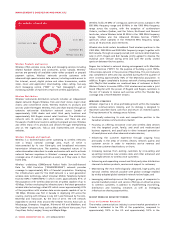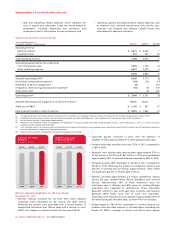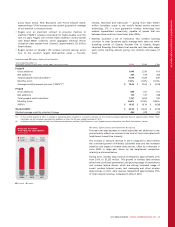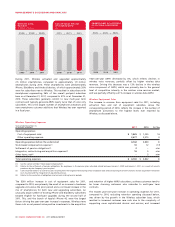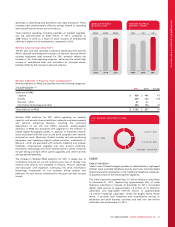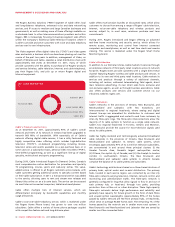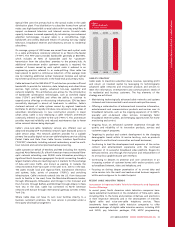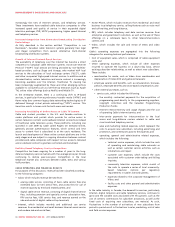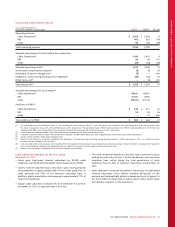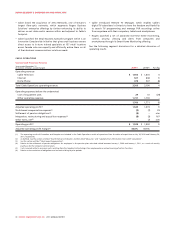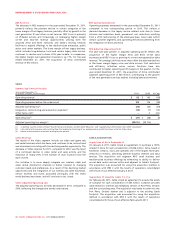Rogers 2011 Annual Report Download - page 38
Download and view the complete annual report
Please find page 38 of the 2011 Rogers annual report below. You can navigate through the pages in the report by either clicking on the pages listed below, or by using the keyword search tool below to find specific information within the annual report.MANAGEMENT’S DISCUSSION AND ANALYSIS
increasingly fast tiers of Internet services, and telephony services.
These investments have enabled cable television companies to offer
increased speed and quality of service in their expanded digital
television packages, PVR, HDTV programming, higher speed Internet
and telephony services.
Increased Competition from Alternative Broadcasting Distribution
Undertakings
As fully described in the section entitled “Competition in our
Businesses”, Canadian cable television systems generally face legal
and illegal competition from several alternative multi-channel
broadcasting distribution systems.
Growth of Internet Protocol-Based Services
The availability of telephony over the Internet has become a direct
competitor to Canadian cable television systems. Voice-over-Internet
Protocol (“VoIP”) local services are being provided by non-facilities-
based providers, such as Skype and Vonage, who market VoIP local
services to the subscribers of local exchange carriers (“ILEC”), cable
and other companies’ high-speed Internet services. In addition and as
discussed below, certain television and movie content is increasingly
becoming available over the Internet. Traditional TV viewing has
been increasingly augmented by these and other emerging options
available to consumers such as over-the-top television (such as Apple
TV), online video offerings (such as Netflix) and Mobile TV.
In the enterprise market, there is a continuing shift to IP-based
services, in particular from asynchronous transfer mode (“ATM”) and
frame relay (two common legacy data networking technologies) to IP
delivered through virtual private networking (“VPN”) services. This
transition results in lower costs for both users and carriers.
Increasing Availability of Online Access to Cable TV Content
Cable and content providers in the U.S. and Canada continue to
create platforms and portals which provide for online access to
certain television content via broadband Internet connections instead
of traditional cable television access. These platforms, including one
launched in late 2009 by Cable called Rogers On Demand Online,
generally provide authentication features, which control and limit
access to content that is subscribed to at the user’s residence. The
launch and development of these online content platforms are in the
early stages and are subject to ongoing discussions between content
providers and cable companies with respect to how access to televised
and on-demand content is granted, controlled and monetized.
Facilities-Based Telephony Services Competitors
Competition has been ongoing for a number of years in the long-
distance telephony service markets with the average price per minute
continuing to decline year-over-year. Competition in the local
telephone market also continues between Cable, ILECs and various
VoIP providers.
CABLE OPERATING AND FINANCIAL RESULTS
For purposes of this discussion, revenue has been classified according
to the following categories:
• Cable, which includes revenue derived from:
• analog cable service, consisting of basic cable service fees plus
extended basic (or tier) service fees, and access fees for use of
channel capacity by third and related parties; and
• digital cable service revenue, consisting of digital channel service
fees, including premium and specialty service subscription fees,
PPV service fees, VOD service fees, and revenue earned on the
sale and rental of digital cable set-top terminals;
• Internet, which includes monthly and additional use service
revenues from residential and small business Internet access service
and modem sale and rental fees;
• Home Phone, which includes revenues from residential and small
business local telephony service, calling features such as voice mail
and call-waiting, and long-distance;
• RBS, which includes telephony and data services revenue from
enterprise and government customers, as well as the sale of these
offerings on a wholesale basis to other telecommunications
carriers; and
• Video, which includes the sale and rental of DVDs and video
games.
Cable’s operating expenses are segregated into the following
categories for assessing business performance:
• Cost of equipment sales, which is comprised of cable equipment
costs; and
• Other operating expenses, which include all other expenses
incurred to operate the business on a day-to-day basis, service
existing subscriber relationships, as well as attract new subscribers.
These include:
• merchandise for resale, such as Video store merchandise and
depreciation of Video DVD and game rental assets;
• employee salaries and benefits, such as remuneration, bonuses,
pension, employee benefits and stock-based compensation; and
• other external purchases, such as:
• service costs, which includes the following:
• the monthly contracted payments for the acquisition of
programming paid directly to the programming suppliers,
copyright collectives and the Canadian Programming
Production Funds;
• Internet interconnectivity and usage charges and the cost
of operating Cable’s Internet service; and
• Inter-carrier payments for interconnection to the local
access and long-distance carriers related to cable and
circuit-switched telephony service;
• sales and marketing related expenses, which represent the
costs to acquire new subscribers, including advertising and
promotion, and commissions paid to third parties; and
• operating, general and administrative related expenses,
which includes the following:
• technical service expenses, which include the costs
of operating and maintaining cable networks as
well as certain customer service activities, such as
installations and repair;
• customer care expenses, which include the costs
associated with customer order-taking and billing
inquiries;
• community television expenses, which consist of
the costs to operate a series of local community-
based television stations per regulatory
requirements in Cable’s licenced systems;
• expenses related to the corporate management of
Video; and
• facility costs and other general and administrative
expenses.
In the cable industry in Canada, the demand for services, particularly
Internet, digital television and cable telephony services, continues to
grow and the variable costs associated with this growth, such as the
cost of content, commissions for subscriber activations, as well as the
fixed costs of acquiring new subscribers, are material. As such,
fluctuations in the number of activations of new subscribers from
period-to-period result in fluctuations in sales, marketing, cost of sales
and field services expenses.
34 ROGERS COMMUNICATIONS INC. 2011 ANNUAL REPORT




